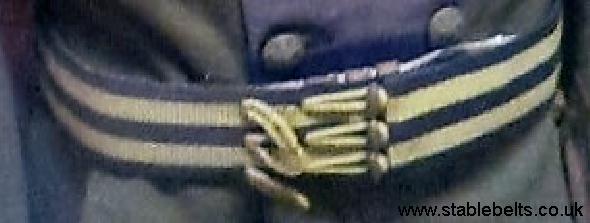
The Sussex Yeomanry have cavalry origins and their stable belt pre WW1 was blue with 2 yellow bands.
The official pattern book identifies it as “Dublin Fusilier Blue” but in reality it was a mid or “royal” shade of blue with two yellow/golden bands running through it (this is the same as that currently used by the Queen’s Own Yeomanry).
After WW1 the regiment re-rolled to Royal Artillery (1922). With the introduction of battledress, the stable belt appears to have been mostly dropped, but the officers may have continued to used the blue and yellow belt (as they also retained the Sussex Yeomanry cap badge for distinction) but the enlisted soldiers used RA cap badges.
During the period you requested (1950s-1967) the Sussex Yeomanry merged with several other RA units on 3 occasions, and whilst the “Sussex Yeomanry” title was retained, the stable belt used was “Royal Artillery” throughout, as it gave a “common thread/identity”, as it was already being used by all the units being merged.
1947 : TA Reformed. 344 (Sussex Yeomanry) Regt RA
1950 : 344 (Sussex Yeomanry) Regt RA absorbs 605 (Sussex) Regt RA
1955 : 344 is merged with 641 (Sussex) Regt RA, 313 (Sussex) Regt RA and 258 (Sussex) Regt RA to become 258 (Sussex Yeomanry) Regt RA
1961 : 258 is merged with 257 (County of Sussex) Regt RA to become 257 (Sussex Yeomanry) Regt until 1967
1967 : 200 (Sussex Yeomanry) Bty RA is formed from 257 Regt RA as part of the new 100 Medium Regt RA
I have seen blue belts with the two yellow bands in the modern format, with the two leather buckle fasteners on the side, but cannot 100% confirm that these are Sussex Yeomanry, as the Queens Own Yeomanry adopted the same (possibly because there was no conflict as it had already been dropped from use by the Sussex Yeomanry, or that the “official” shade of blue was described differently, despite essentially looking the same? Prussian Blue and Dublin Fusilier Blue?)
With thanks to Capt Paul E Mason RA